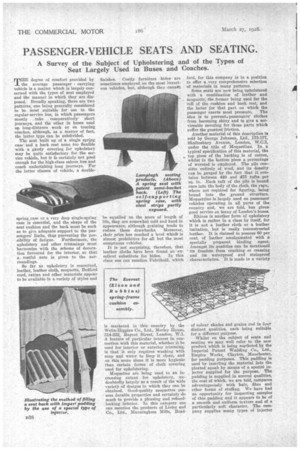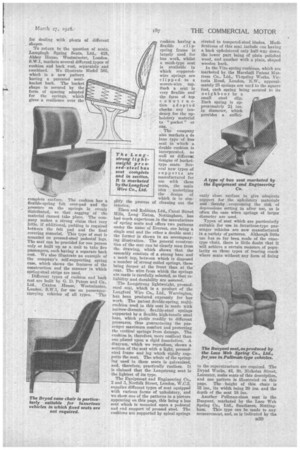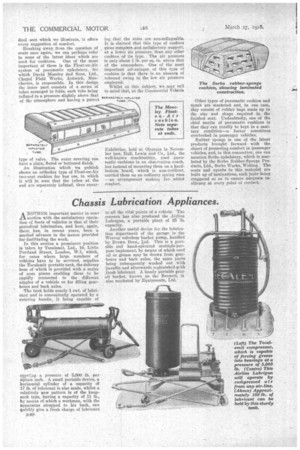PASSENGER-VEHICLE SEATS AND SEATING.
Page 100

Page 101

Page 102

If you've noticed an error in this article please click here to report it so we can fix it.
A Survey of the Subject of Seat Largely Used Upholstering and of the Types of in Buses and Coaches.
TECE degree of comfort provided by the average passenger carrying vehicle is a matter which is largely concerned with the types of seat employed and the manner in which they are disposed. Broadly speaking, there are two patterns, one being generally considered to be most suitable for use in the regular-service bus, in which passengers mostly take comparatively short journeys, and the other in buses used op long-distance work or on touring coaches, although, as a matter of fact, the latter type can be subdivided.
The seat built up of a single spring case and a back rest stone, too flexible with a gaudy covering for upholstery may be quite satisfactory for the service vehicle, but it is certainly not good enough for the high-class saloon bus and coach undertaking long journeys. For the latter classes of vehicle, a double spring_ease or a very deep single-spring case is essential, and the shape of the seat cushion and the back must be such as to give adequate support to the passengers' limbs, thus preventing the pos sibility of fatigue. Furthermore, the upholstery and other trimmings must harmonize with the scheme of decoration favoured for the interior, so that a restful note is givento the surroundings.
So far as upholstery is concerned, leather, leather cloth, moquette, Bedford cord, rattan and other materials appear to be available in a variety of styles and finishes. Costly furniture hides are sometimes employed on the most luxurious vehicles, but, although they canniit be equalled on the score of length of life, they are somewhat cold and hard in appearance, although graining tends to reduce these drawbacks. Moreover, _their price has reached a level which is almost prohibitive for all but the most sumptuous vehicles.
It is not surprising, therefore, that leather cloths have been found• an ex cellent substitute for hides. In this class one can mention Fabrikoid, which is marketed in this country by the Welin-Higgins Co., Ltd., Morley House, 314-322, Regent Street, London, W.1. A feature of particular interest in connection with this material, whether it be used for interior or exterior trimming, is that it only requires washing with soap and water to keep it clean, and on this score alone it is more hygienic than certain forms of cloth covering used for upholstering.
Moquettes are being used to an increasing extent for upholstery, undoubtedly largely as a result of the wide varietk of designs in which they can be obtained. Good-quality moquettes possess durable properties and certainly do much to provide a pleasing and refinedlooking interior. In this category one can mention the products of Lister and Co., Ltd., Man ningham Mills, Brad
ford, for this company is in a position to offer a very comprehensive selection • of materials in many patterns.
Some seats are now being upholstered with a combination of leather and . moquette, the former being used for the roll of the cushion and back rest, and • the latter for that part on which the passenger exerts most pressure. The idea is to prevents passengers' clothes from becoming shiny and to give a serviceable covering for those parts which suffer the greatest friction.
Another material of this description is sold by George Johnson, Ltd., 173-177, Shaftesbury Avenue, London, W.C.2, under the title of Moquettino. In a typical specification of this material, the top piece of the backing is of cotton, whilst in the bottom piece a percentage of worsted is ettiployed. The pile eon-, sists entirely of wool, and its density cast be gauged by the fact that it contains between 440 and 475 tufts per sq. in. Each tuft of the pile is bound once into the body of the cloth, the yarn, where not required for figuring, being bound into the ground structure.
• Moquettino is largely used on passenger vehicles operating in all parts of the country and, we are told, has given good service on many of London's buses.
Rhinos is another form of upholstery which is rather in a class by itself, for it is not a leather cloth or a leather imitation, • but is really reconstructed leather. It is claimed to possess BO per cent. of leather amalgamated with a specially prepared binding agent. Amongst its qualities can be mentioned ' its freedom from cracking or creasing and its waterproof and stainproof characteristics. It is made in a variety of colour shades and grains and in four distinct qualities, each being suitable for a different purpose.
Whilst on the subject of seats and seating we may well refer to the new product which is being marketed by the Imperial Patent Wadding Co., Ltd., Empire Works, Clayton, Manchester, for padding purposes. This padding is used by inserting the material into the pleated squab by means of a special injector supplied for the purpose. The padding is supplied in several qualities, the cost of which, we are told, compares advantageously with hair, fibre and other forms of stuffing. We have had an opportunity for inspecting samples of this padding and it appears to be of a smooth and uniform texture and of a particularly soft character. The company supplies many types of injector
for dealing with pleats of different shapes.
To return to the question of seats, Lamplugh Spring Seats, Ltd., 419, Abbey House, Westminster, London, S.W.1, markets several different types of cushion and back rest, separately and combined. We illustrate Model 505, which is a new pattern having a patented semibucket back. The bucket shape is secured by the form of spacing adopted for the springs, which gives a resilience over the complete surface. The cushion has a flexible-spring felt over-pad and the pressure on the springs is evenly distributed, so that sagging of the material cannot take place. The company makes a strong claim that very little, if additional, padding is required between the felt pad and the final covering material. This type of seat is mounted on pressed-steel pedestal legs. The seat can be provided for one person only or built up as a unit to take five passengers, each having a separate back rest. We also illustrate an example of the company's self-supporting spring case, which shows the features of the construction and the manner in which spring-steel strips are used.
Different types of cushion and back rest are built by G. D. Peters and Co., Ltd., Caxton House, Westminster, London, S.W.1, for use on passengercarrying vehicles of all types. ' The
cushion having a flexible clipspring frame is largely used for bus work, whilst a mesh-type seat is available in which copperedwire springs are clipped to a woven-wire top. Such a seat is very flexible and the form of top constr uction adopted checks any tendency for the upholstery material to " pocket " or sag.
The company also markets a de luxe type of bus seat in which a double cushion is incorporated, as
T h e Longwell as different strong lightdesigns of bucket weight p r e stype seats. Sev sedste el bus eral new types of seat complete supports are and in section. manufactured for It is marketed use with these by the Long ford seats, the main Wire Co., Ltd. idea , underlying
the design of which is to simplify the process of cleaning out the interior.
Elsa and Robbins, Ltd., Canal Street Mills, Long Eaton, Nottingham, has had much experience in the manufacture of spring scats and offers two patterns under the name of Everest, one being a single seat and the other a double seat ; the former is shown in an accompanying illustration. The general construction of the seat can bd clearly seen from the drawing, which shows that the assembly consists of a strong base and a meshtop, between which is disposed a number of strong coiled springs, these being deeper at the front than at the rear. The wire from which the springs are made is carefully selected, so that reliability and durability are assurer],
The Longstrong lightweight, pressedsteel seat, which is a product of the Longford Wire Co., Ltd., Warrington, has been produced expressly for bus work. The patent double-spring, multicushion used in this seat is made with narrow-diameter, flexible-steel springs supported by a flexible high-tensile steel base, which yields readily to different pressures, thus guaranteeing the passenger maximum comfort and protecting the vertical springs from damage. The cushion is, therefore, more resilient than one placed upon a rigid foundation. A diagram, which we reproduce, shows a section of the seat with a light, pressedsteel frame and leg which rigidly supports the seat. The whole of the springing used in these seats is galvanized, and, therefore, practically rustless. It is claimed that the Longstron,g seat is the lightest of its type.
The Equipment and Engineering Co., 2 and 3, Norfolk Street, London, W.C.2, supplies different types of seat equipped with various forms of upholstery, and we show one of the patterns in a picture appealing on this page, this being a bus seat which is mounted upon a pedestal and end support of pressed steel. The cushions are supported by spiral springs
riveted to tempered-steel blades. Modifications of this seat include one having a back upholstered only half-way down, the lower part being of plain polished wood, and another with a plain, shaped wooden back.
the Vito spring cushions, which are marketed by the Marshall Patent Mattress Co., Ltd., Vi-spring Works, Victoria Road, London, NAV., approximately 25 springs are used to the square foot, each spring being secured to its neighbour by a small steel clip. Each spring is approximately at ins. in diameter, which Provides a suflici ently close surface to give adequate support for the upholstery materials and thereby overcoming the risk of depressions setting in after use, as is often the case when springs of larger diameter are used.
Types of seat which are particularly suitable for use in luxurious-type passenger vehicles are now manufactured in a variety of patterns. Although little use has so far been made of the canetype chair, there is little doubt that it will achieve a certain measure of popularity on those types of touring coach where seats without any form of fixing to the superstructure are required. The Dryad Works, 42, St. Nicholas Street, Leicester, make seats of this description, and one pattern is illustrated on this page. The height of this chair is 32 ins., its width being 20 ins, and the depth of the seat 18 ins.
Another Pullman-class seat is the Buoyant, marketed by the Lace Web Spring Co., Ltd., Sandiaere Nottingham. This type can be made to any measurement, and, as is indicated by the olnal. seat which we illustrate, it offers every suggestion of comfort.
Breaking away from the question of seats once again, we can perhaps refer to some of the latest ideas which are used for cushions. One of the most important of these is the Float-on-Air system of pneumatic upholstery, for which David Moseley and Sons, Ltd., Chapel Field Works, Ardwick, Manchester, is responsible. In this design the inner part consists of a series of tubes arranged in folds; each tube being inflated to a pressure slightly above that type of valve. The outer covering can have a plain, fluted or buttoned finish,'
An illustration which we publish shows an orthodox type of Float-on-Air two-seat cushion for bus use, in which it will be seen that the tubes at the end are separately inflated, thus ensur
ing that the sides are non-collapsable. It is claimed that this type of cushion gives complete and .satisfactory support, at a lower air pressure, than any other cushion of its type. The air pressure is only about lb. per sq. in. above that of the atmosphere. One of the most important advantages of this type of cushion is that there is. an absence of rebound owing to the low air pressure employed.
Whilst on this Subject, we may call to mind that, at the Commercial Vehicle Exhibition, held at Olympia in November last, Hall, Lewis and Co., Ltd., the well-known coachbuilder, used pneumatic cushions in an observation coach, but instead of mounting them on a hardbottom board, which is non-resilient, carried them on an ordinary spring case —an arrangement making for added comfort. Other types of Pneumatic cushion and squab are marketed and, in one case, they consist of rubber bags made up to the size and shape required in the finished seat. Undoubtedly, one of the chief merits of pneumatic cushions is that they can readily be kept in a sanitary condition—a factor sometimes overlooked in passenger vehicles.
Rubber sponge is one of the latest products brought forward with the object of promoting comfort in passenger vehicles, and, in this connection, one can mention Sorbo upholstery, which is marketed by the Sorbo Rubber-Sponge Products, Ltd., Sorbo Works, Woking. The seats and squabs in this material are built up of laminations, each layer being staggered so as to ensure adequate resiliency at every point of contact.




























































































































































































